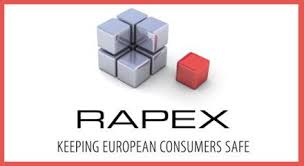RAPEX NETWORK
In 2005, the European Union (EU) set up the rapid alert system (RAPEX) for dangerous non-food products, based on the General Product Safety Directive (Directive 2001/95/EC). The aim of this system is to accelerate the information exchange and cooperation on product safety. In 2010, this network included also alerts on products posing other risks (other than for health or safety), such as environmental risks, and products exclusively for professional use. Food, pharmaceutical products or medical devices are not included in the RAPEX system.
Through this system, national authorities (responsible for product safety) are able to send alerts to the European Commission, where they report the measures taken against products posing a risk. After checking all the information reported, the Commission publicly publishes it on the ‘Safety Gate’ website, informing consumers about dangerous products.
Companies have the responsibility to place safe products on the market and the national authorities need to check if the companies comply with their obligations, conducting regular inspections and sampling of products for testing. The Product Safety Business Alert Gateway is the tool set up by the Commission to facilitate companies reporting. Consumers may also report dangerous products to the national authorities.
2019 RAPEX REPORT – COSMETICS
In 2019, there were 2243 alerts received in the system on measures taken against dangerous products. There were 4477 follow-up actions taken by the competent authorities in response to the alerts concerning dangerous products.
96 cosmetic products (sold in shops or internet) from 27 countries were subject to withdrawal, recall or prohibition of marketing (6% of notifications reported). From these, skin lightening products, perfumes, body care and hair dyes accounted for more than half of the notifications for cosmetics (approximately 56%). Almost 60% of notifications concerning cosmetics are justified by the presence of prohibited ingredients (e.g. MI/MIT, certain colorants, heavy metals, formaldehyde, medicinal substances, hydroquinone), whilst 18.75% are due to microbiological contamination.
National authorities have detected chemicals which can result in serious risks to consumers’ health and safety. For example, in 2019, 10 alerts concerned cosmetic products containing mercury. This metal has the ability to accumulate in the human body, damage the kidneys, brain and nervous system and can affect reproduction.
Carcinogenicity is a significant hazard that remains amongst the potential health effects. Compared to the previous year, there was a slight decrease in the alerts involving products containing substances which may induce cancer in long term (such as cosmetics, tattoo inks and toys) reported on the Safety Gate (2019). Aromatic amines and nitrosamines, nitrosatable substances, polycyclic aromatic hydrocarbons (which interfere with DNA) and cadmium are among the chemicals commonly detected and that continue a key source of concern.
Tattoo inks may contain several chemical components that may pose risks to the health of consumers and also to the professionals handling such products. Polycyclic aromatic hydrocarbons, benzo[a]pyrene, cadmium and lead were detected in tattoo inks and can lead to serious health problems.
Another cause of concern are the products made available online. 16% of the alerts in 2019 mentioned that the dangerous products were sold online. Checking and testing these products can be tricky, especially if the seller is located outside the EU.
References:
- European Commission – 2019 Results of the Rapid Alert System for dangerous non-food products. Available at: https://ec.europa.eu/consumers/consumers_safety/safety_products/rapex/alerts/repository/content/pages/rapex/reports/docs/RAPEX.2019.report.EN.pdf
- Directive 2001/95/EC of the European Parliament and of the Council of 3 December 2001 on general product safety. Available at: https://eur-lex.europa.eu/legal-content/EN/TXT/PDF/?uri=CELEX:32001L0095&from=EN















